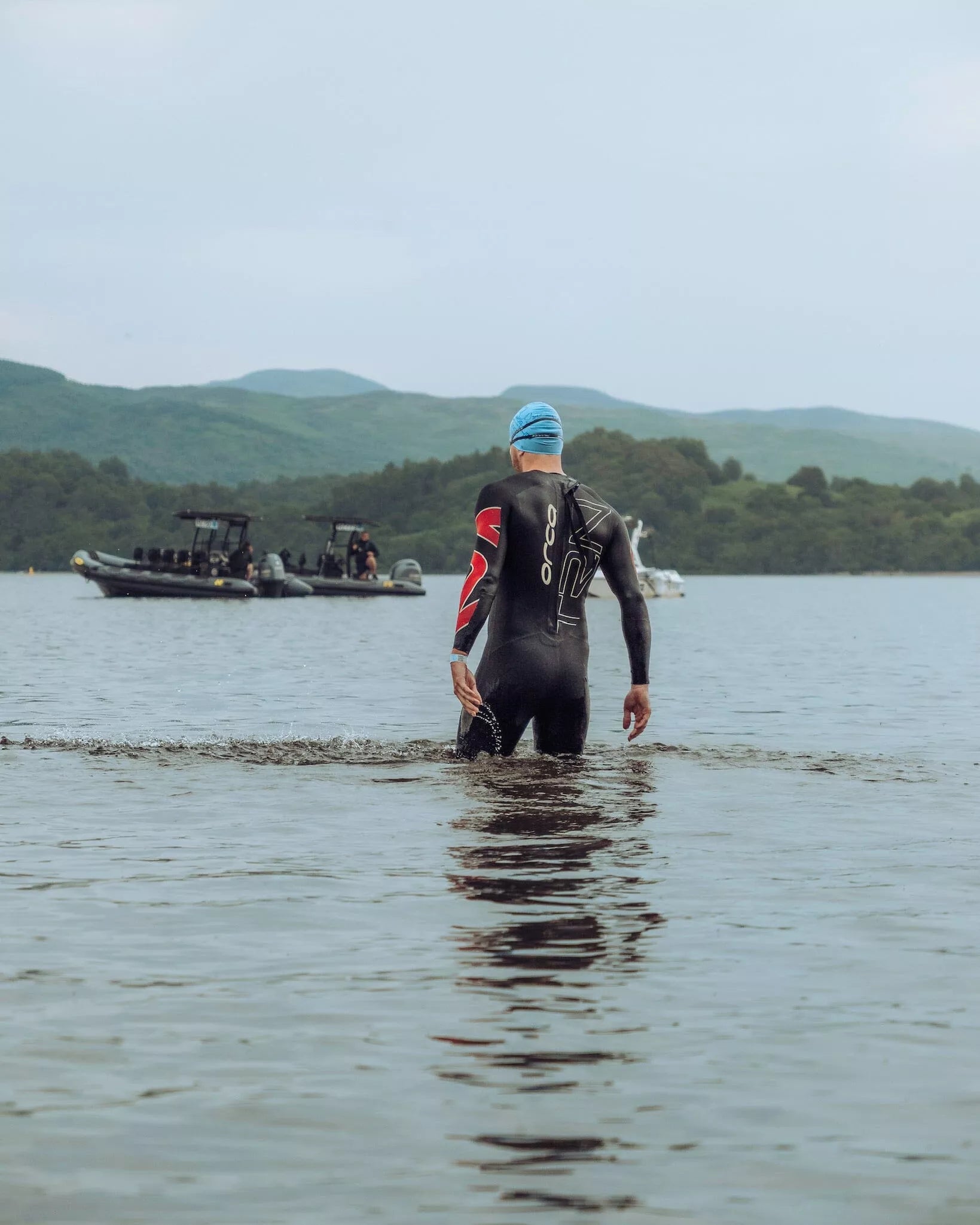Welcome to our Seashell blog posts where we dive into the stories of the Seashell people, share our advice and experience to help build the community. We hope to use this space and platform to inspire others and to start important conversations.
Let's get exploring!

"What is the best way to train?".
How to get started.
Some may associate triathlon as a weird form of self-torture done by mad endurance junkies who like pain. For some it is but others it is a way of life, community and great adventures.
With thousands of women, men and girls and boys participating in their first ever triathlon each year, triathlon is becoming more and more mainstream.
It has become a popular way to get fit, push mental and physical fitness and be a rewarding challenge to do with others.
Being a beginner for any sport is intimidating. Triathlons however, include three disciplines which at first thought may put people off but actually, it is a lot less scary than you think. What you will find is that training for each discipline will in turn help the others and improve overall fitness.
Only thing to be scared about is getting addicted to it and wanting to race every weekend (trust me, it happens).

So what exactly is a Triathlon?
Here are short summaries of what each discipline entails for doing a triathlon.
Swimming:
That's right, for triathlon we start in the water! Sometimes it is in the pool but many times they are in lochs or the sea. Swimming in a triathlon is pretty different from competitive indoor swimming.
Yes the ultimate goal of completing the distance as fast as possible is still the same. However in triathlon, you are aiming to be as efficient as possible to save energy (especially your legs) for the bike and run which is to come.
Cycling:
Most of us learnt to ride a bike many years ago. Triathlon cycling on the other hand is quite different to our stabilized bike days. Adopting more of a race mindset from our leisure rides is what makes all the difference.
Cycling in a triathlon is the middle man and on average takes up the most time between the three disciplines. Get used to your bike seat as you get those legs accustomed to all those miles to come.
Running:
Training to run in a triathlon is a little different to training for running on it's own. It is all about being able to run efficiently with tired legs after having done the swim and the bike. Although about 70% of your race is already done, you still need to get those legs moving to get you over the finishing line (hopefully with a smile on your face).


" I am not confident enough to cycle on the roads yet".
Here is your answer:
Cross Triathlon:
For those who are a tad scared of cycling on the roads or prefer being even more covered in mud, then a Cross triathlon is for you.
A cross triathlon, or X-tri, is an off-road triathlon. Typically an open water swim, mountain bike and then a trail run.
You don't have the added stress of being on the road with other road users.
Some races are closed road races but these tend to be much bigger races.
The distances vary just like doing a road triathlon so you will find there is a distance that suits you. Whether you want to ease yourself into it or go for the longer routes.
Personally doing a cross- triathlon is my favourite as aerodynamics don't really come into play and I love feeling like I am in the wilderness.

"I don't have a road or triathlon bike"?
Although triathlons are competitions, it does not have to be a race. What you will find with the triathlon community is that is it so inclusive. No matter your age, stage, ability or what equipment you do or don't have, you are always welcome!
It is easy to be very intimidated when rocking up at your first triathlon and to see all the fancy bikes etc.
Do not be fooled! The kit you have does not define you, your speed or enjoyment.
Of course, if you are wanting to get out there and qualify for something like the age groups world championships for example.
In that case you will be trying to go as fast as you can and there are some things you can change within your kit to make you go faster but if you are new to it and doing it for the fun (everyone should be anyways) then the kit just does not matter!
Borrow a bike, use a mountain bike for a road race if you like, it may take longer but who cares? Wear whatever you feel most comfortable and enjoy the process.
You will find that as you are running along, the other competitors will be cheering you along!
For me, triathlon is not about the racing itself, its about all the comes with it. The community, the training and the enjoyment your body and mind get from doing all of the above.
Just remember, you cannot control what anyone else does. You only have control of you. Whether you come 1st, 6th ,23rd, last or did not finish, if you can get out there and give what you can on that day then that is a success in my eyes!
Start with the shorter distances!
Although the Ironman World Championship event is arguably the most recognizable triathlon event in the world, if you are a beginner, starting your triathlon days with a novice/ super sprint distance and working your way up is probably the best way to go.
Give yourself some insight into how it feels and how your body adapts to switching from one discipline to the other. You can increase your training bit by bit as you then target longer distances. Of course you do not have to aim for longer distances if that does not suit you.
For example, some people find a distance that really suits them and stick to it for a while. Experiment and see how far you can healthily push your mind and body and experience how your mind sets and goals change from race to race.
Triathlon distances:
Swim/bike/run
Super sprint:400m/10km/2.5km
Sprint distance:750m/20km/5km
Standard distance:1500m/40km/10km
Middle distance:2.5km/80km/20k
Long distance:4km/120km/30km
Ironman distance: 3.8km/180km/42km.

Find an event near you.
For your first ever triathlon, try and find an event which is close to home. Doing this allows you to do a recce of the race course before hand which should increase your confidence.
Being able to cycle the bike route often comes in quite handy as you can suss out tight corners, pot holes and any potential down hill sections that you can target. If the event is an easy drive from your house it can also reduce hassle and stress (especially if you are forget your swimming costume and need to nip home). Hopefully it doesn't ever come to that and you have everything in your bag.
Bring a friend along
You will be surprised at how many people would like to give triathlon a go but are too scared to do it by themselves.
Of course, like any new thing it can be daunting to begin with, so find a buddy to take along to training and competitions.
You can even ask a friend to come a support you at a race. Be it your partner, children, parents, colleagues. This can put you more at ease knowing that someone you know is there and can potentially drive you home if your legs have completely gone.

See bellow for a list of races in Scotland I recommend from personal experience. Most have different distances on the day to choose from.
Aviemore Cross Triathlon.
Craggy Island Cross Triathlon.
Westhill Triathlon.
Inverurie Triathlon.
Turrif Triathlon.
Huntly Triathlon.
Monikie Triathlon.
Aberfeldy Triathlon.
St Mary's Loch Triathlon.
Knockburn Loch Triathlon.
Planning Ahead.
Use your calendar to plan out which weekends you are free. Search for entry central or Si entries online to find events near you and any events that you fancy doing.
Sign up as many as you like/can and put them in bold into your calendar. This is a great way to plan for training and get ready for each race. If you know you have a race coming up in 4 weeks you can plan your training so you are ready. You can also use some smaller races as training to practise your transition. This also means you can really target the bigger races and it shouldn't feel so daunting.
Make sure you are prepared for before, during and after the race to make it as enjoyable as possible. Make sure to fuel and get used to fuelling before swimming etc. You can practice this by taking bars and gels etc on training rides to see how your body deals. We are all different so don't be afraid to experiment.
Wear warm clothes and have them ready for after the race.
For example, a seashell towelling robe, changing robe, beanie with lots of other warm clothes, a hot water bottle and flask of tea for post race would get you dry and warm after which is important for not getting ill afterwards.
Make sure to get food in as soon as you can!
Here is a basic kit list of things you might need.
Swimming:
- Swimming costume or trisuit.
- Goggles.
- Swim cap (they usually provide a cap but are usually thin can then slip off whilst you are swimming which can be very annoying so wear 2).
- Wetsuit (if wetsuit compulsory, depends on temperature of water).
Cyling:
- Bike - Your choice of road, triathlon (areo), mtb, gravel.
- Helmet.
- Cycling shoes or trainers.
- Water bottle in bike.
-Some nutrition- bars and/or gels.
-Sunglasses to stop dirt getting in your eyes.
Running:
- Running shoes.
-Often you will need a number belt so you can wear it throughout the race so they know who you are.

Rated No.1
"Seashell Robes have the best robes on the market and they’re growing in popularity."
"Not only do Seashell make waterproof changing robes, but they also have their own community. Seashell practice what they preach and put their products to good use in wild swimming and fitness community events up in Scotland."

How should I train?
In a triathlon you will normally spend about 20% of the total race swimming, 50% cycling and 30% running. Ideally your training should roughly match the percentage of the time spent in a race. Doing equal number of training for each discipline per week is also ideal.
For example if you work out three times per week you will do one session of each. You will have strengths and weaknesses. Try not to neglect your weakness. Often people end up spending more time doing what they love which is fine but if you are wanting to improve on all three then its important to work on your weaknesses too.
In general, making your bike training rides longer will hopefully help your overall race time as you will spend most of your time on the bike. However if you are already a very keen cyclist and struggle a lot with your swimming, you should aim to add in more swimming sessions and maybe have your technique looked at.
Finally, enjoy it!
Yes, sometimes it will be tough but if you go into training and competitions with a positive attitude and an open mind, you will get sooo much more out of it. Enjoy it and be proud of what you are doing. Imagine where you will be in a year from now and all the progress you will have made.
It is an amazing feeling that I cannot describe.
Get out there and enjoy it!
Here is to trying a triathlon!
Please please get in contact with me if you have any questions at all and I will be happy to help.
Coralie Dee.

Seashell.
Thank you very much for reading our blog post. We hope it has inspired you to go and give a triathlon a go.
Our aim is to share other people's stories. Whether you have a story about mental health, community or why you started wild swimming for example.
If you would like to be featured in our Seashell stories then email us on: support@seashellcsc.com


5 Unknown Benefits of Cold Water: Training Ebook - FREE PDF BELOW:






The Freedom of Loch Swimming.
How Wild Swimming Changed my Life.